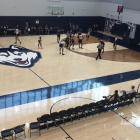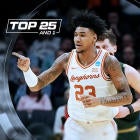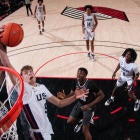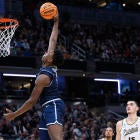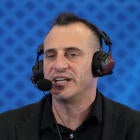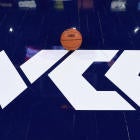STORRS, Conn. -- Just 18 coaches speckle the lower level of Gampel Pavilion, near the south-facing entrance of the venue during a session of the NCAA's new youth development camps. Tens of feet away, a nondescript, marginally sloppy game between mostly low-major (or lower) 2020 men's college basketball prospects plays out on the most prominent and prestigious slab of basketball hardwood in Connecticut.
Though the venue is terrific, if not ideal, everything else about this picture is a stark departure from the frenzied crowds, amplified environment, hordes of coaches and loaded talent pool of the Nike Peach Jam, which was held two weeks prior in North Augusta, South Carolina.
These College Basketball Academies are in their first year, a material NCAA response to the bribery and corruption recruiting scandal. Four are happening simultaneously around the country -- Phoenix, Houston and Champaign, Illinois, are currently hosting the other three -- and they are not without some irrefutable benefits. The NCAA pays round-trip airfare for each player and one parent/guardian. They stay for free and are provided three meals per day. In addition to the games and workouts, players learn about the college-eligibility process, undergo athletic testing and have their measurements taken. They hear from NBA and the NBA Players Association reps (even if there isn't one future NBA player here, it's an earnest attempt).
Plus, coaches can attend at a lower cost (no charge for otherwise overpriced recruiting packets) to their school than most other July recruiting affairs. The NCAA initially budgeted $10 million out of its treasure house for these four academies; it's paying a lot of people plenty of money as it cumbersomely tries to enter the recruiting space.
But, cosmetically, you can even sense it in the air here: the operation feels deficient in spite of itself.
Deficient in attendance; very few fans are showing up to watch this.
Deficient in talent; not one elite prospect showed up for this.
Deficient in buzz; I spotted only two other media members in Storrs on Thursday.
There's even an intramural feel thanks to the generic uniforms the players wear, including most having triple digits on their backs. Referees have oversized safety pins affixing numbers to their shirts.
The NCAA has a long way to go in turning its sure-to-be-annual academies into a vogue destination for prominent high school prospects. Who knows if that will ever come to be, and if it doesn't, this well-intentioned countrywide event could settle into being a perennial inferior recruiting showcase that concludes the summer calendar, which is the most pivotal time of the year for recruitment in college basketball.
"Coaches' initial feedback has been there's been a kid here or there they've been able to get a fine eye on, but it doesn't have the breadth of guys and talent and options that you would find at an AAU event," former Fairfield and Princeton coach Sydney Johnson told me. "Those are just facts. I would say, quite honestly, they didn't need to come to figure that out. My two cents, and this is all subjective, but I don't know if this will ever be like a Peach Jam or any other kind of very-well-run -- and to be fair to everybody, not all AAU events are created the same, and that sometimes gets left out of the discussion -- but if you're talking about Peach Jam, which is excellent, or the (Adidas) Gauntlet, which is excellent, those are anywhere from seven to 10 of the area's best kids playing on one team vs. … 30 other teams that look like that."
Johnson is in an interesting position at the moment. He was fired from Fairfield in March after eight seasons. He's being paid by the NCAA to work this UConn camp, but has intentions on coaching in an assistant's role, if possible, in Division I next season. At the very worst, Johnson should be back on a D-I bench for 2020-21. He will almost certainly be sitting in the stands as opposed to working the clinics when these academies are held next summer. He was sure to point out that the model of this vs. the model of "AAU tournaments" are intentionally different.
That's the point.
"An apples-to-apples comparison, certainly with this in its infancy, just doesn't make sense," Johnson said. "On the other side, what's not talked about: these big-time AAU events, there's a lot of kids who have to play because they're top-100. And so now my kid, hypothetically a mid-major kid, he's watching a whole lot of really good kids playing and then going in and playing five-to-10 minutes. You're going to tell me that serves him or her well? That's debatable."
But here's the surprise: nearly a dozen coaches I spoke with at UConn and elsewhere were generally OK with where things have landed this year with the academy. And "generally OK" is a noticeable upgrade from the disaffected attitude that was pervasive as recently as earlier this month, in advance of the academies starting. Coaching attendance wasn't great but that's a direct correlation to the overall lack of Division I players participating at all four of these showcases.
"Us bitching about it won't change it, so we need to accept and embrace this," said one coach who asked not to be identified.
Another coach did point out that this new NCAA-sponsored weekend was not optimal for recruiting purposes, and for all the money put toward this six-day event (it started Monday and will conclude Sunday), high-profile head coaches at multiple programs still had not been punished by the NCAA. He expressed cynicism whether they ever would be.
"I feel a lot of coaches struggled with the lack of evaluation opportunities when kids were playing and competing," Lehigh coach Brett Reed said. "There was about six hours in a day when the only thing to see was 5-on-0 set-play implementation, dry defensive drills and some shooting drills. Then, all the teams would play during the same time blocks and there'd be kids you'd want to evaluate but couldn't. If the academies were thoughtful and staggered the games and had different divisions playing games at different times of the day, then coaches would have more opportunities to evaluate and less frustration."
UConn's event did bring out a few big names to boost its legitimacy, even if those names were there for morale and appearances as much as anything else. Most notably, Kentucky's John Calipari took a private plane up, but it was a favor for event organizers — and for Calipari to report back to the NABC and the oversight committee he sits on. Whatever needs fixing or tweaking with the Academy, Calipari will recommend it and almost certainly have the influence and power to help it come to fruition a year from now.
Notre Dame's Mike Brey, St. John's Mike Anderson, Wake Forest's Danny Manning, Ohio State's Chris Holtmann and a few other coaches from power-conference schools also attended the activities in Storrs. Plenty of assistants from big leagues came, too. There wasn't an abundance of even three-star talent at the UConn site, but coaches did get out to watch in spurts. (Weirdly, for all of the Division II and Division III prospects this event attracted, there were very few coaches representing D-II and D-III.)
The camps themselves seem to be well-run and offering something of value for the teenagers. Brady O'Connell is a rising senior from North Carolina who was one of the nearly 300 players who came here. O'Connell is the younger brother of Duke guard Alex O'Connell; their father went to Duke as well. Brady isn't drawing big-school attention like Alex did, though. His wooers include Mercer, Samford, Furman, UNC Greensboro and Houston Baptist, amongst others.
For him, the Academy was without a doubt worth the mostly free trip.
"I had a good travel season, but it wasn't what I wanted, so I came up here for a bit more exposure," O'Connell said. "I wanted to work on my craft a little more."
O'Connell is an ideal player for an event like this. He's good enough to play with a shoe-company team -- he played with both Team Felton (Under Armour) and Georgia Stars (Nike) this year -- but still wanted more and didn't have opportunities elsewhere in the end of July. O'Connell said everything outside of actual gameplay showed him how he has a long way to go to get to where he wants to be.
"When you get to the next level, it's going to be like this all the time," he said. "So it showed me how my body isn't conditioned to that level yet."
O'Connell was an interesting participant in an event that drew some notable names, like top-100 prospect Noah Farrakhan, in addition to three-star 2020 guys such as Zed Key and Silas Mason. Reece Brown, one of the better mid-major prospects in the country, also attended and lured plenty of suitors.
In reality, those kind of players aren't moving the needle. The problem is obvious, the solution problematic: the NCAA needs to get top-100 prospects to show up. And not five or 10. More like 50, 60, 70 of the best rising seniors. You do that, you get the biggest coaches, you get more media attention, you bring more legitimacy to the academies.
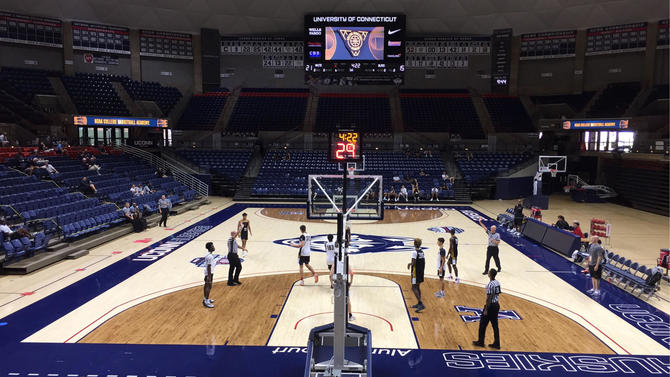
But there's a schism that will be tough for the NCAA to repair. Last year, when the Commission on College Basketball made its recommendations to change the recruiting calendar, it sent an insulting and broadly presumptive message at grassroots basketball organizers -- many of whom are good people with good intentions. The men and women who run and operate these programs have power, sure, but something even more than that: influence.
So when the NCAA chopped off two of July's three recruiting weekends focused around grassroots hoops events (often referred to as "AAU tournaments" even though many of the events aren't run by the Amateur Athletic Union), it effectively hurt players' exposure chances. It also dinged grassroots coaches/team organizers' ability to make money and started a cold war the NCAA was likely expecting while having no idea of its true wide-ranging consequence.
It is no coincidence that more than 90 percent of the top 100 prospects in the Class of 2020 will not show at the academies this week. Multiple sources told CBS Sports that they were advised not to, in many cases, by their grassroots coaches. Even in cases where that didn't happen, multiple coaches speculated to me that most five- and four-star prospects believed, or were led to believe, they had little use for the academies anyway. They've received their offers, the most important weekend of the offseason came and went (Peach Jam weekend, which also had Under Armour and Adidas hold its premier events in nearby cities), and so they shut it down.
Be it out of spite or otherwise, these academies are rife with issues when it comes to this and the deeply flawed player nomination process, in which coaches were asked to pick the prospects they believed worthy of competing in these events -- exposing their recruiting targets in the process. College coaches are already paranoid enough when it comes to recruiting warfare. The NCAA was asking for another level of transparency, and when you figure that who you recruit is largely connected to you keeping your job, it's no shock that the quality of player didn't come close to meeting the NCAA's ideal.
So what can the NCAA do? The best solution would be to move July's lone grassroots weekend to the end of the month, but Nike almost certainly isn't shifting its Peach Jam position on the calendar. Adidas and Under Armor will follow that lead, of course. The NCAA will fall well short of its goal with its academies if it can't bring in most of the best high school prospects in America. With grassroots coaches coming from all sections of the country and having different allegiances to shoe companies, there is no singular union or organization the NCAA can meet with to accomplish its goals. Even if you get 10 of the better grassroots programs to partake in this, there are another 60-70, minimum, to convince.
These academies could grow into something better in in 2020, maybe truly notable in 2021 and beyond. But they can't do that without shoe companies and those in the grassroots space compromising, in addition to the NCAA acting in kind. For an organization with a mountain range of problems -- public and private -- this has become one of its more fascinating complications.
As for the players who came, Johnson said most who were here participated in essentially every aspect of the proceedings: player development, skill work, life-skills forums, social media advice. The camps are steeped in instruction and hands-on tutelage. It's not just hooping with as many games as possible for exposure.
Everything from how to use Twitter to how to slide through a ball screen.
"They wanted to be here and it was clearly evident from their body language, attentiveness, work ethic and improvement that they wanted to make the most of this experience," Johnson said." Whatever discussion is being had on how the camps can be improved or tweaked, that's one thing that was perfect and the players have set a standard now that I would never want to change."
The nomination process is still a problem, though. A glaring one.
"I don't know know how many kids were told not to come, that's not my issue, but I do know there may have been some kids who didn't come and weren't aware and didn't take advantage of something that was absolutely free, work with coaches and get exposure," Johnson said. "If you have all that information in front of you, I think more kids will opt into that."
From the pure recruiting and evaluation perspective, the academies are inferior. They don't put the best players against each other in a tournament format with as many coaches as possible watching the games. But that's not the NCAA's objective here. If that point hasn't been lost by coaches and others in the game, it's been discarded.
"It's a different model," Johnson said. "It's not intended to be Peach Jam. It's just not. I went to Five-Star Camp and Metro Index and it was nothing like AAU, and I'm glad. But you have to have AAU. You cannot go away from the AAU model because it serves so many kids. But this is a camp setting with some games. I hope people see the difference and that the two of them could be really good moving forward."
The question is not if July can exist with only one model or the other. The NCAA is going to insist it exists with both. But everyone from the coaches to the parents to the players to the NCAA has to give up ground to find a common one. When one of the first things coaches and players are saying about these academies is that they weren't a disaster, it's a signal that a problem still exists and will linger for reasons that have little to do with what exactly is happening this week in Storrs, Phoenix, Houston and Champaign.












